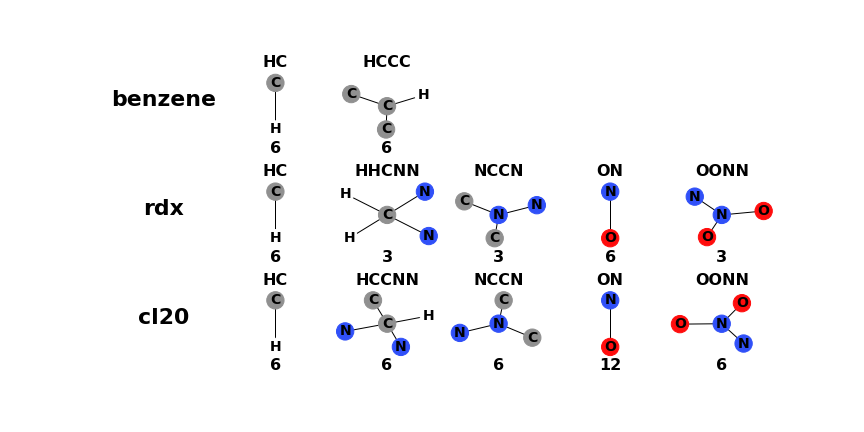Library and utilities for training volume estimation models with PyMoVE. Capable of calculating the solvent accessible surface area of a molecule using a marching cubes algorithm optimized for molecules.
This library is published to accompany the following peer-review article. Please cite this article for any work that makes use of the PyMoVE library.
Bier, I., & Marom, N. (2020). Machine Learned Model for Solid Form Volume Estimation Based on Packing-Accessible Surface and Molecular Topological Fragments. The Journal of Physical Chemistry A, 124(49), 10330-10345.
doi.org/10.1021/acs.jpca.0c06791
It's highly recommended to start from an Anaconda distribution of Python, which can be found here.
Current full installation requires running two setup.py scripts. This will be modified in the near future. This is because the algorithm that enables the project marching cube algorithm relys on Numba compilation to run efficiently. The algorithm is still accessible and built in pure Python if a user cannot compile with Numba for any reason. But will require some changes. Please open an issue on github if these changes are required for you.
Running the following commands installs the complete PyMoVE library:
python setup.py install
python setup_numba.py installAfter installation, basic usage of the solid-form volume prediction can be obtained through the command-line.
$ pymove examples/Example_Structures/molecules/benzene.xyz
Predicted Solid-Form Volume of benzene: 119.93509896777675There are two fundamental types of objects in pymove.
Structure- The
Structureobject is the definition of aclassin Python that stores the geometry of a molecule or crystal structure, itsstruct_idand its properties, such DFT energy, lattice parameters, space group, or structural descriptor. StructDict- The
StructDictis a Pythondictionaryof structure objects. The key for eachStructureis itsstruct_idin the dictionary.pymovewill work with any Pythondictthat has been defined in this way and does not require any other special class.
The fundamental file for pymove is the Structure.json file format.
This is the same file format for Genarris/GAtor. json file formats are a
standard way of storing information that look and behave a lot like a Python
dictionary. You should never have to create a Structure.json file from
scratch. Rather, use the pymove.io functionality to convert a FHI-aims
geometry file, for example, to a Structure.json file.
Analysis functions in pymove will accept either a Structure or a
StructDict. The function will tailor the task they perform based on
whether they recieve a pymove.Structure object or a Python dict object.
Because of this, the same commands that analyze a single Structure can be
used for the analysis of a collection of structures.
The input and output capabilities, often just called io, is one of the
core functionality of pymove that enables users to be more productive.
pymove reads Structure.json files using built in functions and uses
ASE.io to read other file types that are then to pymove.Structure
objects in memory. pymove will automatically detect how to read a file
based on the file's file extension. However, the user may also explicity
define the file type.
ioTo use this functionality add the following line to the top of a Python script:
from pymove.io import read,write
read(struct_path, file_format="")The
readfunction has one required argument, thestruct_path. This is the path to either a file or a directory. The functionality ofreadwill change depending on if it detects the path is a file or a directory.- File: The file will be read into memory and returned as a
Structureobject. - Directory: All of the files in the directory will be attemped to be read into memory. Each file in the directory will be automatically detected for its file type. This means that even a folder containing a heterogenous mixture of file types will all be read into memory. The
Structureswill be returned as aStructDict. Thestruct_idwill be assigned bystruct_idcontained in theStructure.jsonfile. If the filetype is not aStructure.json, then astruct_idwill be created for it using the filename without its file extension.
The
file_formatis an optional argument. Iffile_formatis specifiedpymovewill assume all of the files it attempts to load are this format. This functionality is important if the files are missing the correct file extension for one reason or another. If you manage your files correctly, this option should rarely be needed.- File: The file will be read into memory and returned as a
write(path, struct_obj, file_format="json", overwrite=False)Let's go throught the arguments for the
writefunction.path: Path to the location where you would like thestruct_objto be saved. If thestruct_objis aStructure, this should be the path to a single file. If thestruct_objis aStructDict, then the path will be the location of a folder.struct_obj: Either aStructureor aStructDict. Thewritefunction will automatically detect the object type.file_format: By default, the file format is for aStructure.jsonfile. This can be changed togeooraimsfor a FHI-aims file format or to any of the acceptedASEfile formats.overwrite: Be default, if a file already exists with the same name,writewill throw anException. This is so the user cannot overwrite files by accident. Only ifoverwrite=Truewillwritereplace existing files.
Maybe you can now see the power of the read and write capabilities.
It is trivial for the user to read in thousands of CIF or FHI-aims
geometry files and convert them all to Structure.json file formats.
This can even be done from a Python terminal because it's so easy.
For example, if we have geometry files in a directory named geometry_folder
that we want to convert to Structure.json files, we can type:
>>> from pymove.io import read,write
>>> struct_dict = read("geometry_folder")
>>> write("json_folder", struct_dict, file_format="json")
The examples directory steps though all features of the PyMoVE library. These are:
- Finding molecules from the molecular crystal structure
- Calculating the packing factor of molecular crystals
- Calculating the topological fragment descriptor
- Calculating the packing accessible surface
- Model training & testing and evaluating volumes using the pre-trained model


